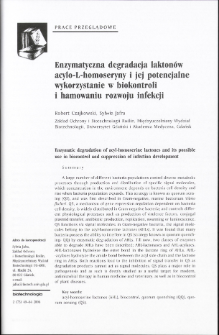
Obiekt
Tytuł: Enzymatic degradation of acyl-homoserine lactones and its possible use in biocontrol and suppression of infection development
Inny tytuł:
Wydawca:
Committee on Biotechnology PAS ; Institute of Bioorganic Chemistry PAS
Abstrakt:
A large number of different bacteria populations control diverse metabolic processes through production and distribution of specific signal molecules, which concentration in the environment depends on bacteria cell density and rise when bacteria population expands. This strategy is known as quorum sensing (QS), and was first described in Gram-negative, marine bacterium Vibrio fischeh. QS, a mechanism of gene expression regulation dependent on bacteria cell density, is widely distributed in Gram-negative bacteria; and controls different physiological processes such as production of virulence factors, conjugal plasmid transfer, antibiotic production, replication, swarming or luminescence. QS functions via signal molecules: in Gram-negative bacteria, the signal molecules belong to the acyl-homoserine lactones (AHLs). It was found that many bacteria possess the ability to interfere in QS (strategy known as quorum quenching- QQ) by enzymatic degradation of AHLs. Till now, two classes of enzymes able to degrade AHLs have been described: AHL-lactonases and AHL-acylases. AHL-lactonases hydrolyze the ester bond in the lactone ring of AHLs. AHL- -acylases hydrolyze the amide bond between the acyl side chain and the lactone ring in AHLs. Both reactions lead to the inhibition of signal transfer in QS as degradation products cannot act as signal molecules. QS plays a major role in pathogenesis and as such is deeply studied as a useful target for modern, antimicrobial therapy in human medicine and veterinary, as well as in biocontrol of plant diseases.
Czasopismo/Seria/cykl:
Biotechnologia, vol.73, 2 (2006)-.
Tom:
Zeszyt:
Strona pocz.:
Strona końc.:
Szczegółowy typ zasobu:
Format:
Identyfikator zasobu:
0860-7796 ; oai:rcin.org.pl:87550 ; IChB B-69
Źródło:
Library of Institute of Bioorganic Chemistry PAS
Język:
Język streszczenia:
Zakres czasowy:
Prawa:
Creative Commons Attribution BY-SA 4.0 license
Zasady wykorzystania:
Digitalizacja:
Institute of Bioorganic Chemistry of the Polish Academy of Science
Lokalizacja oryginału:
Institute of Bioorganic Chemistry of the Polish Academy of Science
Dofinansowane ze środków:
Dostęp:
Kolekcje, do których przypisany jest obiekt:
- Repozytorium Cyfrowe Instytutów Naukowych > Kolekcje Partnerów > Instytut Chemii Bioorganicznej PAN > Artykuły
- Repozytorium Cyfrowe Instytutów Naukowych > Piśmiennictwo > Czasopisma/Artykuły
Data ostatniej modyfikacji:
2 paź 2020
Data dodania obiektu:
11 gru 2019
Liczba pobrań / odtworzeń:
388
Wszystkie dostępne wersje tego obiektu:
https://www.rcin.org.pl/publication/114194
Wyświetl opis w formacie RDF:
Wyświetl opis w formacie RDFa:
Wyświetl opis w formacie OAI-PMH:
Obiekty Podobne
Borkowska, Bożenna
Ziółkowski, Piotr Babula- Skowrońska, Danuta Kaczmarek, Małgorzata Cieśla, Agata Sadowski, Jan
Poddębniak, Mateusz Jafra, Sylwia
Jafra, Sylwia Łojkowska, Ewa
Jafra, Sylwia Łojkowska, Ewa

 INSTYTUT ARCHEOLOGII I ETNOLOGII POLSKIEJ AKADEMII NAUK
INSTYTUT ARCHEOLOGII I ETNOLOGII POLSKIEJ AKADEMII NAUK
 INSTYTUT BADAŃ LITERACKICH POLSKIEJ AKADEMII NAUK
INSTYTUT BADAŃ LITERACKICH POLSKIEJ AKADEMII NAUK
 INSTYTUT BADAWCZY LEŚNICTWA
INSTYTUT BADAWCZY LEŚNICTWA
 INSTYTUT BIOLOGII DOŚWIADCZALNEJ IM. MARCELEGO NENCKIEGO POLSKIEJ AKADEMII NAUK
INSTYTUT BIOLOGII DOŚWIADCZALNEJ IM. MARCELEGO NENCKIEGO POLSKIEJ AKADEMII NAUK
 INSTYTUT BIOLOGII SSAKÓW POLSKIEJ AKADEMII NAUK
INSTYTUT BIOLOGII SSAKÓW POLSKIEJ AKADEMII NAUK
 INSTYTUT CHEMII FIZYCZNEJ PAN
INSTYTUT CHEMII FIZYCZNEJ PAN
 INSTYTUT CHEMII ORGANICZNEJ PAN
INSTYTUT CHEMII ORGANICZNEJ PAN
 INSTYTUT FILOZOFII I SOCJOLOGII PAN
INSTYTUT FILOZOFII I SOCJOLOGII PAN
 INSTYTUT GEOGRAFII I PRZESTRZENNEGO ZAGOSPODAROWANIA PAN
INSTYTUT GEOGRAFII I PRZESTRZENNEGO ZAGOSPODAROWANIA PAN
 INSTYTUT HISTORII im. TADEUSZA MANTEUFFLA POLSKIEJ AKADEMII NAUK
INSTYTUT HISTORII im. TADEUSZA MANTEUFFLA POLSKIEJ AKADEMII NAUK
 INSTYTUT JĘZYKA POLSKIEGO POLSKIEJ AKADEMII NAUK
INSTYTUT JĘZYKA POLSKIEGO POLSKIEJ AKADEMII NAUK
 INSTYTUT MATEMATYCZNY PAN
INSTYTUT MATEMATYCZNY PAN
 INSTYTUT MEDYCYNY DOŚWIADCZALNEJ I KLINICZNEJ IM.MIROSŁAWA MOSSAKOWSKIEGO POLSKIEJ AKADEMII NAUK
INSTYTUT MEDYCYNY DOŚWIADCZALNEJ I KLINICZNEJ IM.MIROSŁAWA MOSSAKOWSKIEGO POLSKIEJ AKADEMII NAUK
 INSTYTUT PODSTAWOWYCH PROBLEMÓW TECHNIKI PAN
INSTYTUT PODSTAWOWYCH PROBLEMÓW TECHNIKI PAN
 INSTYTUT SLAWISTYKI PAN
INSTYTUT SLAWISTYKI PAN
 SIEĆ BADAWCZA ŁUKASIEWICZ - INSTYTUT TECHNOLOGII MATERIAŁÓW ELEKTRONICZNYCH
SIEĆ BADAWCZA ŁUKASIEWICZ - INSTYTUT TECHNOLOGII MATERIAŁÓW ELEKTRONICZNYCH
 MUZEUM I INSTYTUT ZOOLOGII POLSKIEJ AKADEMII NAUK
MUZEUM I INSTYTUT ZOOLOGII POLSKIEJ AKADEMII NAUK
 INSTYTUT BADAŃ SYSTEMOWYCH PAN
INSTYTUT BADAŃ SYSTEMOWYCH PAN
 INSTYTUT BOTANIKI IM. WŁADYSŁAWA SZAFERA POLSKIEJ AKADEMII NAUK
INSTYTUT BOTANIKI IM. WŁADYSŁAWA SZAFERA POLSKIEJ AKADEMII NAUK


































